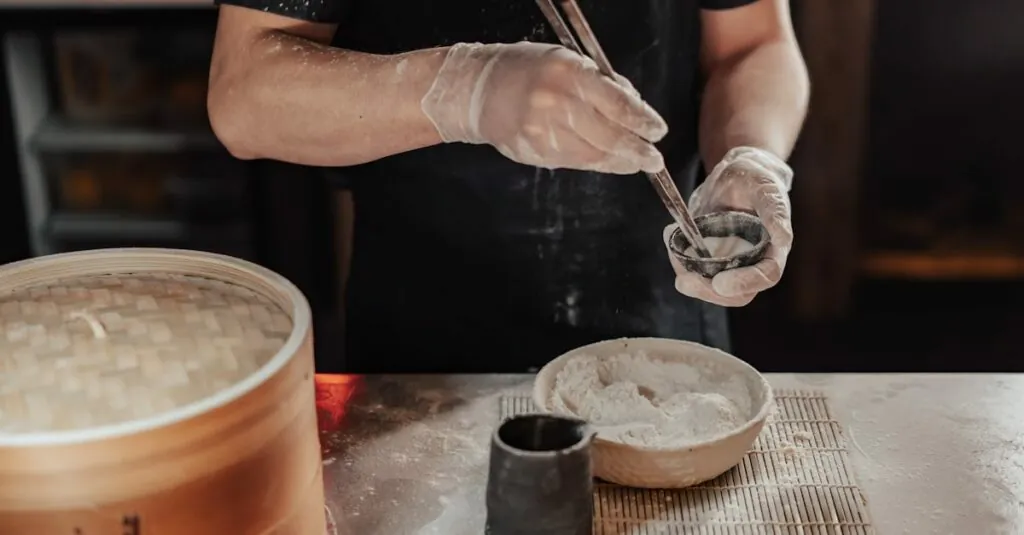Table of Contents
ToggleWhen it comes to culinary adventures, few cuisines can rival the magic of Chinese cooking. It’s not just about tossing ingredients into a wok and hoping for the best; it’s a symphony of techniques, each note harmonizing to create mouthwatering masterpieces. From the art of stir-frying to the delicate dance of steaming, Chinese cooking techniques have been perfected over centuries, transforming simple ingredients into extraordinary dishes.
Overview Of Chinese Cooking Techniques
Chinese cooking techniques encompass a diverse array of methods, each adding distinct flavors and textures to dishes. Stir-frying ranks among the most recognized techniques, known for quick cooking over high heat that preserves ingredients’ vibrancy and nutrients. Marinating enhances flavors, as it allows proteins and vegetables to absorb seasonings before cooking.
Another vital method, steaming, retains the natural moisture and nutrients in food, often resulting in tender and flavorful dishes. Braising combines both moist and dry heat, making it ideal for tougher cuts of meat, allowing them to become succulent over extended cooking periods.
Deep-frying introduces a satisfying crispiness, a crucial element in many regional dishes. Dry-frying or pan-frying requires less oil, producing dishes with unique textures while maintaining health-conscious options.
Roasting, especially in a traditional Chinese oven, infuses meats with complex flavors through the caramelization of sugars and Maillard reactions. Wok cooking is central to many techniques, as the unique shape of the wok allows for quick cooking and even heat distribution.
Fermentation plays a significant role in many regional cuisines, enhancing flavors and creating unique products like soy sauce, pickles, and fermented tofu. Each technique reflects the culture and regional diversity of China, demonstrating a sophisticated understanding of how cooking affects taste and nutrition.
Key Elements Of Chinese Cuisine
Chinese cuisine showcases a blend of flavors, textures, and aromas that reflect its rich heritage. Mastery of essential elements elevates dishes and creates memorable dining experiences.
Flavor Profiles
Flavor profiles in Chinese cooking focus on harmony and balance. Sweet, sour, salty, bitter, and umami work together to create complex tastes. Each region offers unique flavor characteristics, such as the spicy heat of Sichuan cuisine and the fresh, light flavors of Cantonese dishes. Ingredients like ginger, garlic, and scallions enhance the overall taste, while sauces such as soy sauce, oyster sauce, and black bean sauce add depth. Balancing these flavors ensures a well-rounded dish that delights the palate.
Essential Ingredients
Essential ingredients form the backbone of Chinese dishes. Rice serves as a staple, pairing well with numerous meals. Noodles bring versatility, featuring variations like egg noodles and rice noodles. Fresh vegetables, such as bok choy, snow peas, and mushrooms, provide texture and nutrition. Proteins include pork, chicken, beef, and tofu, offering options for various dietary preferences. Spices and aromatics, including star anise, five-spice powder, and sesame oil, enhance flavors significantly. These ingredients create the foundation for authentic Chinese cooking, each contributing its unique properties.
Popular Cooking Techniques
Chinese cooking techniques showcase a variety of methods that bring out unique flavors and textures in dishes. Each technique plays a vital role in the culinary tradition and reflects regional diversity.
Stir-Frying
Stir-frying involves cooking ingredients quickly in a hot wok with a small amount of oil. This method preserves the color, flavor, and nutritional content of vegetables and proteins. It utilizes high heat and constant movement, resulting in tender yet crisp dishes. Key ingredients often include a mix of seasonal vegetables and proteins like chicken or beef. Seasonings, such as soy sauce and garlic, enhance the overall taste. Mastery of stir-frying lies in proper timing and heat management, making it a fundamental technique in Chinese cuisine.
Steaming
Steaming stands out for its ability to retain moisture and essential nutrients in food. It uses a bamboo steamer or metal rack over boiling water, allowing steam to cook ingredients gently. This method favors delicate items like fish, dumplings, and vegetables. Preservation of natural flavors occurs since no oil is involved. Seasonings can be added pre-steaming to infuse subtle tastes into the dish. Many traditional dim sum recipes highlight the effectiveness of steaming, showcasing its role in maintaining healthy and flavorful options.
Braising
Braising combines two cooking techniques: searing and slow-cooking in liquid. The process begins with browning meats in a hot pot, followed by adding liquid, such as broth or wine. After that, low and slow cooking occurs until the meat becomes tender and flavorful. Ingredients, like aromatic vegetables and herbs, enhance the depth of flavor. Braising suits tougher cuts of meat, transforming them into succulent dishes. Signature dishes, such as red-cooked pork, highlight the importance of this technique in Chinese culinary tradition.
Deep-Frying
Deep-frying creates crispy and flavorful textures in a variety of dishes. This technique involves submerging food in hot oil, ensuring even cooking and a golden-brown exterior. Commonly deep-fried items include spring rolls and wontons. Proper oil temperature is crucial for achieving the desired crunch without excess grease. Coatings, such as batter or breadcrumbs, add distinctive textures. Deep-frying plays a significant role in street food culture throughout China, as it continues to delight with its satisfying crunch and robust flavors.
Regional Variations In Cooking Techniques
Chinese cooking techniques vary widely across regions, each boasting distinct methods reflecting local ingredients and cultural preferences.
Cantonese Techniques
Cantonese cuisine emphasizes freshness and simplicity. Steaming stands out as a popular technique, especially for seafood and dim sum, allowing natural flavors to shine. Stir-frying also gains prominence, focusing on quick cooking in a hot wok to maintain vibrant colors and textures. Chefs often utilize light sauces, such as oyster sauce, to enhance dishes without overpowering them. This region values a subtle balance of flavors, which contributes to its reputation for quality.
Sichuan Techniques
Sichuan cuisine is renowned for bold flavors and spicy heat. Techniques like dry-frying enhance the intensity of spices, allowing complex flavors to develop. Stir-frying remains a primary method, with an added twist of Sichuan peppercorns for a unique numbing sensation. Rather than just highlighting heat, thick, flavorful sauces often complement dishes, creating a rich and enticing culinary experience. The local emphasis on fermentation also leads to distinct dipping sauces that enrich meal enjoyment.
Northern Techniques
Northern Chinese cooking techniques reflect a focus on hearty, filling dishes. Boiling stands out as a common method for producing dumplings and noodles. This region’s love for wheat-based ingredients results in variations of noodles that are the foundation of many meals. Slow-cooking also emerges as a popular technique, emphasizing traditional stews that meld flavors over time. Regional spices differ, with a preference for garlic and scallions, providing robust flavor profiles across various dishes.
Chinese cooking techniques offer a fascinating glimpse into a culinary tradition that values balance and harmony. Each method serves a purpose in enhancing flavors and textures while reflecting the unique characteristics of regional cuisines. Whether it’s the quick heat of stir-frying or the gentle touch of steaming, these techniques showcase the artistry behind every dish.
As home cooks explore these methods, they’ll not only create delicious meals but also gain a deeper appreciation for the cultural heritage that shapes Chinese cuisine. Embracing these techniques can transform everyday ingredients into extraordinary culinary experiences, inviting everyone to savor the rich tapestry of flavors that define this remarkable cuisine.



